SURVIVAL IN THE MOUNTAINS
Do you think it is possible to take at least a sip of crystal clear spring water in the mountains without filtering and boiling it? At high altitudes, the water is generally clear. But it is possible that a little upstream some animal was swimming or defecating, which you are unlikely to know about. Cryptosporidiosis, giardiasis, shigellosis, and norovirus are just some of the infections that can occur after drinking untreated water, while filtration or boiling will minimize the risk. Bring the water to a boil to purify it, and let it continue to boil for one minute, plus one extra minute for every 300m above sea level, just in case. If you do not have a container suitable for boiling water, use a plastic bottle, filling it to the very neck so that not a single air pocket remains inside. Since the plastic melts at a higher temperature than the boiling point of water, you can heat the bottle without melting it.
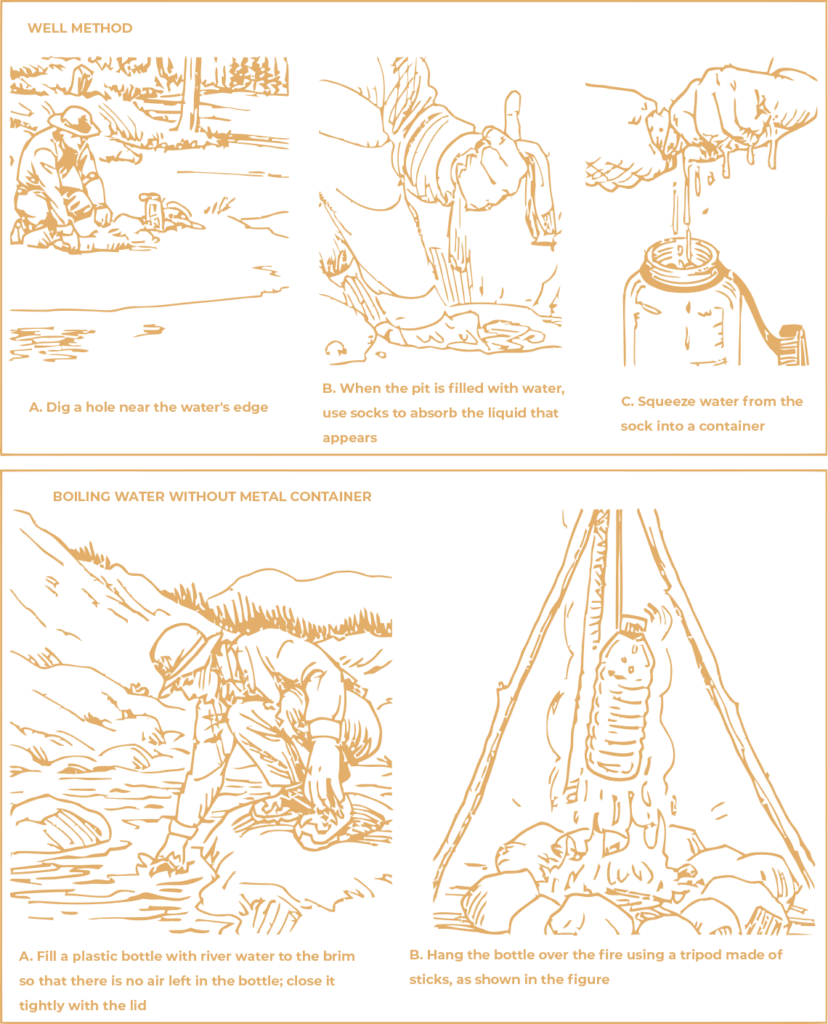
Use a piece of string to tie the bottle to a three-pole tripod. Due to the lack of oxygen, the water will not boil so that it can be seen, but when it reaches the boiling point, tiny bubbles will begin to appear in it. If you cannot light a fire, use a natural filtration system. Dig a hole near the water’s edge, and then use socks or other cloth to absorb any moisture that builds up there. This liquid will already be partially filtered as it passes through the layers of soil and rock.
Do not take water from stagnant bodies of water and puddles. in a warm, humid environment, where they are not affected by the current, bacteria feel especially comfortable.
Keep your hands clean. Some experts believe that for outdoor enthusiasts the threat of bringing bacteria into the body through the hands is much more serious than the harm from dirty water.
When heated, plastic bottles emit carcinogenic substances, and therefore, boiling water in a plastic bottle should only be used as a last resort.
Ignition bonfire from a raw wood
Even in a humid environment, if wood is abundant, the task of starting a fire can always be solved successfully. Please use the guidelines below to suit any environment. If you do everything right, the flames will be strong and hot.
- Seek out pine needles or sticks that are coated in or filled with highly flammable sap.
- If you find a wet log, peel off a couple of layers of bark to expose dry wood.
- A smooth log with a large mass won’t burn very well. Split larger pieces of wood to expose their ragged internal surfaces.
- You need fuel, spark, and air to make a fire. To make sure the last element is in bountiful supply, shape logs into a teepee triangle or a lean-to that allows room for air to circulate. A pile of sticks will eventually smother itself.
- Travel with fire starters like Vaseline, hand sanitizer, or a dedicated store-bought product, or collect lint from your dryer, douse it in lighter fluid, kerosene, or gasoline, and store it in a Baggie.
- Light the fire from the windward side, blocking the wind with your body so the flames don’t blow out before they’re burning strong.
- Light your fire from below. Fire burns upward, and lighting from the lowest point gives the flames every opportunity to climb.
- A good supply of tinder (pine needles, brush, dry leaves) is the lifeblood of an effective fire.
- There’s no overstating the importance of tinder. Add hefty pieces of wood too early, and your fire will go out. Keep adding tinder until your fire has the strength to burn a bigger log.
- Unless strong winds are burning down your fire, a fire pit may be isolated from the airflow necessary to keeping a fire burning. Instead, build your fire atop a mound of dirt.
Finding food in the mountains
There is often a lot of game in the mountainous areas. But if you need to walk the route in a few days and go to a safe place, then you have no time either to make and install traps, or to torment your stomach because of improperly cooked animal meat. Your task – is to continue moving through the terrain, collecting edible vegetation along the way and trying to catch fish, which is possible, if you are lucky – you will meet a pond.
Many lakes and rivers are teeming with fish, and therefore, when events begin to unfold according to the scenario of survival, instead of trying to catch up with the rabbit, it is better to resort to a fishing rod: this way you will save both energy and time.
By installing a trotline, your chances of catching fish will be significantly increased. Attach several different lengths of fishing line to a piece of parachute line or sturdy liana. Attach hooks to these pieces and attach the bait to them. Tie one end of a string, and tie a bottle filled with water or a large rock to the other end and drown it in the water. When you see that the line began to twitch, take out the catch.
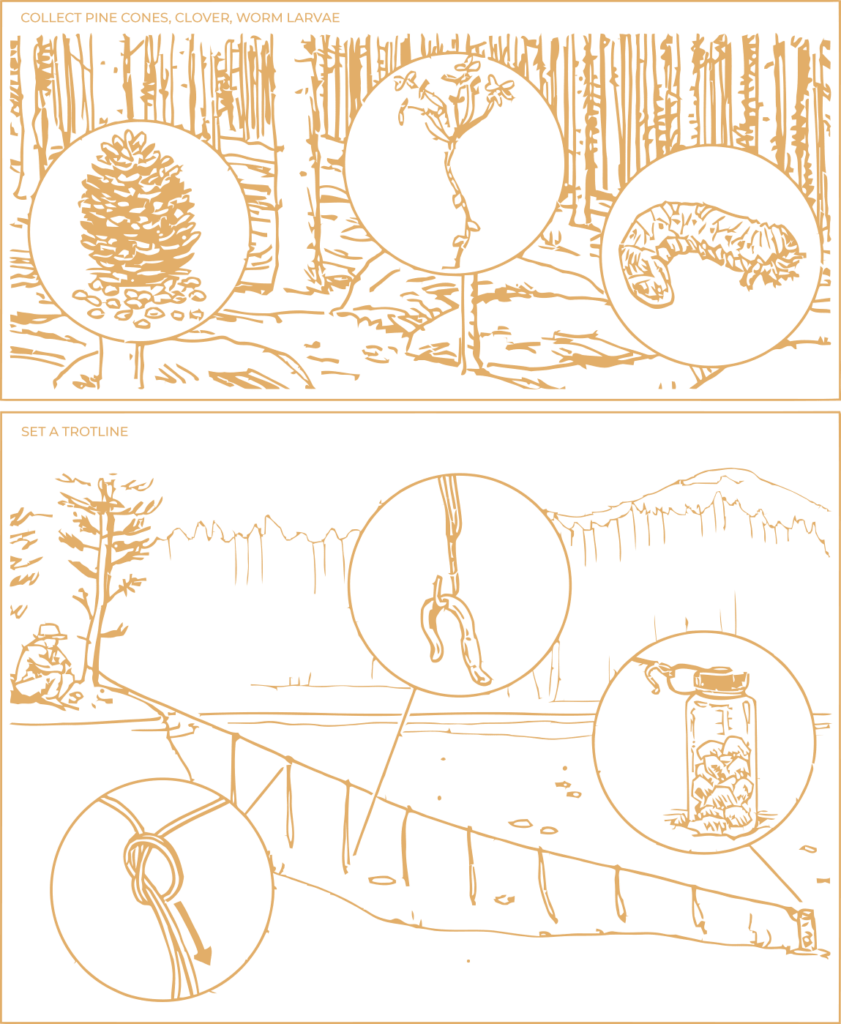
By studying the map of the area while preparing for the hike, find out what edible plants and insects live on this route. Pine cones, clover, and larvae and earthworms are available and safe sources of fats, nutrients and proteins. Select dried-out pinecones whose scales have already opened, smashing them against the ground to release their seeds. Any type of clover is edible and harmless. You can use one rule: any plant you see animals eating is likely to be safe for human consumption.
Shelter construction in the mountains
The appearance of the surrounding area in the mountains is very deceiving. Viewed from afar, the idyllic trail you climbed belongs to a massive, unforgiving ecosystem with the power to alter wind and weather patterns for hundreds of miles. When dusk falls or a cold wind suddenly begins to blow, a sun-drenched rocky ledge can turn into an icy, blown desert in a few minutes.
When you are forced to spend the night on a mountain without a tent, the most important thing is isolation from the external environment.
When going on a trip to the mountainous terrain, it is worth taking a cape cloak with you. Lightweight and practical, it can serve as a tent, a raincoat, a bedding, and an insulating layer. In warm weather, a sleeping bag and bivy sack is enough for spending the night under the stars, but better safe and take more equipment than sorry.
To avoid being in the middle of a stream of water while sleeping at night, after a sudden rain, be sure to make sure that you are not in a dry bed of a stream or river. It is best to stay on a level, elevated area with no slopes or large animal trails nearby, ideally near trees.
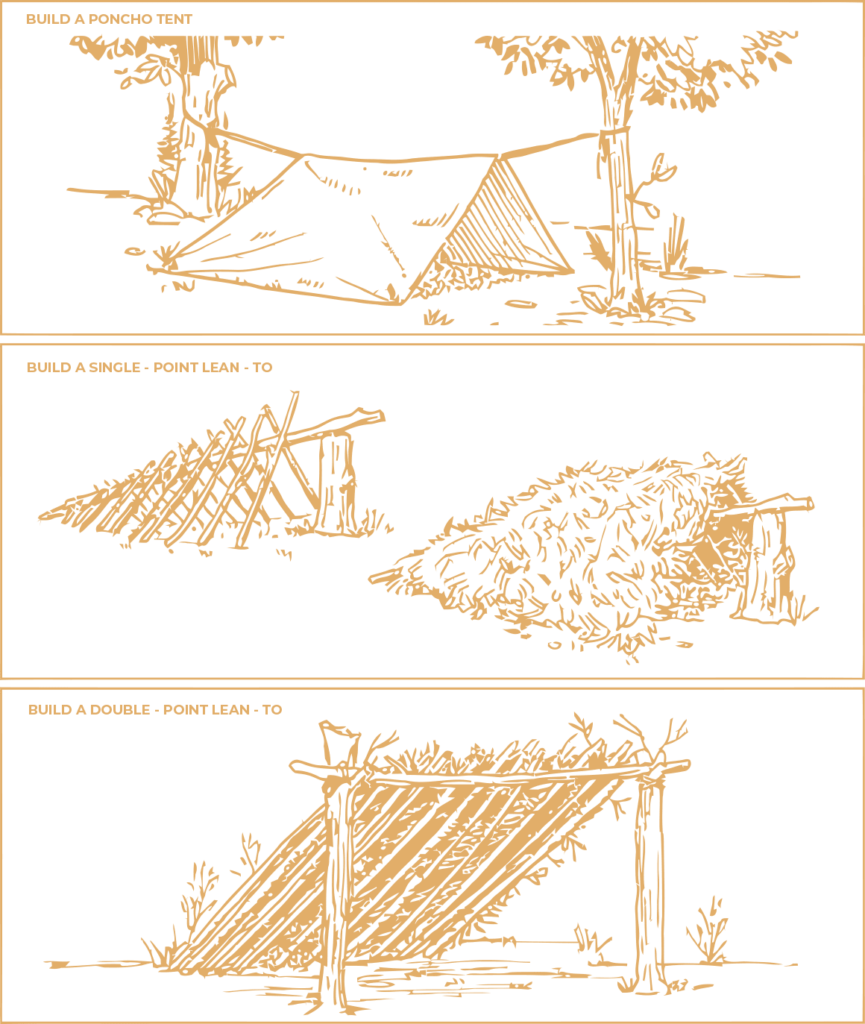
If you travel with good tools, you can make an isolated shelter with branches and foliage. Instead of tree trunks or stumps, you can use ski and hiking poles, as well as ice axes to create a shelter with a canopy from a cape.
Before setting off on a hike through a deserted area, study the map carefully. If you get stuck on a mountain peak, even the most basic ideas about your surroundings will help you in search of a safe path. If you do not know anything about the area in which you find yourself, go downstream of rivers and streams.
Rock climbing techniques useful in critical conditions
Inexperienced climbers often make the same mistake: they rely too much on the strength of the hands, which is why almost everyone, except the most physically strong, gets tired very quickly. Actively using the muscles of the legs and trunk, as well as distributing efforts by using the whole body, and not one muscle group, it will be much easier for you to lift. The key to a successful ascent is natural, simultaneous movements of the whole body. This principle of climbing is quite understandable when it comes to crawling through a chimney or narrow chute. To overcome the chimney, you need put your back on one wall, and with your feet on the other, opposite, and climb up, alternately moving the emphasis from hand to foot and back. There is another option: to give the body the position of the letter X, and then, moving the limbs one by one, like a crab, move up.
To climb the ledge, you must use your arms and legs to rise to the height of your chest, and then, lifting one leg, grab the ledge with your heel, lean on and move your body with your hands.
On a steep climb, your arms do not have to be your highest fulcrum.
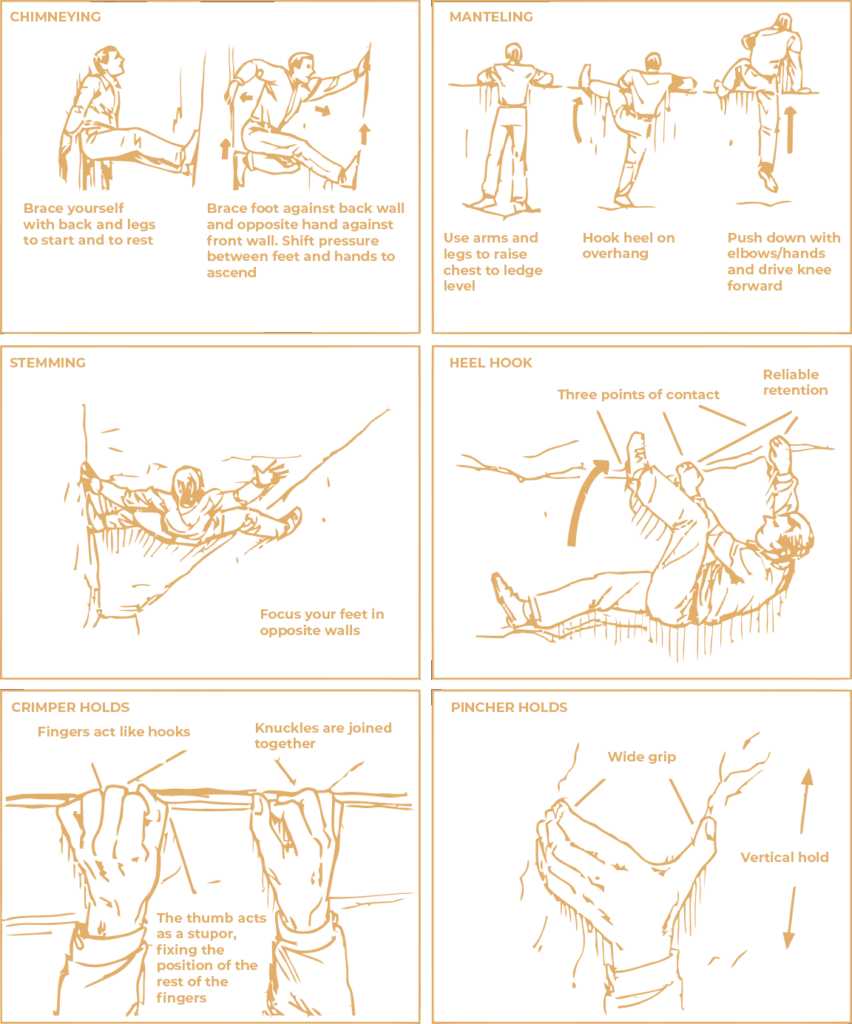
If you can find the third point of contact within reach, press your body as close to the wall as possible, and then swing your leg up to catch the heel higher. Once you are stable again, move your hands to the next point of contact.
When gripping with your hands, rest on your palms, which will distribute your body weight over more points of contact. And do not forget that you can hold on not only to horizontal protrusions: in a critical situation, a vertical protrusion can be equally useful.
Survival when encountering a bear
If you encounter a black bear on a mountain trail, thank fate. They attack humans much less often than white (polar) and brown, which are considered the most aggressive. But the most hungry, and always, is the polar bear, and therefore polar predators actively track people in the Arctic area and hunt them. Due to their large weight and impressive growth, these animals are formidable rivals, capable of ripping open the victim’s stomach with one blow of a clawed paw.
After a focused effort to conserve bear populations across North America, encounters between humans and predatory animals have increased. The number of black bears has increased especially.
Fortunately, attacks are very rare: the likelihood that after such a meeting you will be harmed is 1 in 2.1 million cases, which means that the chances of dying while doing everyday activities are much higher.
However, if you go to hunt moose in the Montana mountains or go mountaineering in the Yellowstone area, the risk increases significantly. In addition, the likelihood of an accidental meeting with a bear in the suburbs, where these predators are attracted by containers with garbage, or even in their own car, where the animal can climb, cannot be completely ruled out.
Usual precautions
Never get caught between a she-bear and her cubs! If you spot a bear from afar, change your route. Remain calm so as not to pique the beast’s interest. If it is impossible to change the direction of movement, stop for a while and, when the bear disappears from your field of vision, wait another 30 minutes.
If you spot bears nearby, start clapping and screaming, making a constant noise as you travel. Bears have a great sense of smell, so whenever you stop overnight, double-pack all food items and hang them above the ground. Any flavored food (toothpaste, soap) should be stored with food and utensils. Do not sleep in the same clothing that you used to prepare food, as the fibers of the fabrics can absorb food odors. Leave food and utensils at least 30m away from the tent, and never set up a camp near bear droppings or bear trails. Whenever possible, cross the bears’ habitats with two or more companions: bears usually do not attack groups.
Keep a whistle and anti-bear spray, a type of pepper spray that has been shown to be more effective than a pistol. The grizzly bears are currently endangered and protected in 48 states, so killing this animal will lead to a federal investigation and a full forensic investigation.
If a bear is nearby and sees you, the situation becomes more dangerous. Start waving your arms and making noise. Often this strategy will cause the bears to first stop and then run away.
What to do in case of a bear attack
In the wild, it is difficult to predict for sure the outcome of an encounter with an animal. Although bears are omnivores, they feed mainly on plants and fish, but, as you know, they love to feast on human flesh.
Never turn your back on the bear or try to run away from it. Both of these actions can make its predatory reflexes work, and you have no chance of overtaking the bear: this animal runs at a speed of 50 km per hour. Instead, slowly step aside, keeping an eye on the beast so you can see all of its movements.
Most experts agree that when the bear attacks, it’s best to fall to the ground and pretend to be dead. This approach allows you to minimize the threat in which you find yourself in the attack. Lie on your stomach to protect important organs, and place your hands on your neck to protect the arteries. Or curl up into a fetal position, covering the back of your neck with your hands.
Feign death – is an effective strategy, with a 75% success rate. In most cases, bears attack in self-defense and, realizing that a person is not dangerous, retreat.
If playing dead does not make the bear lose interest in you, you will become, which rarely happens, the victim of a predator attack. In this case, the bear will want to kill you and, possibly, eat you, and therefore you need to fight off it with any available weapon: a knife, stick, stones, fists. Aim for the eyes and nose it is the most sensitive bear area. If you have anti-bear spray, use it at the moment when the predatory animal is approximately 12 m away from you.

If you decide to resort to firearms, aim below the chin or in the area immediately behind the front paws if the animal is standing sideways to you. If you are unarmed, stay still. The bear may make a tentative attack to test your courage as a potential predator, and if he realizes that you are not a threat to him, then it is possible that he will lose interest in you. There is no strict set of rules for behavior when attacking a bear. This is due, in particular, to the fact that such cases are extremely rare.
Safe crossing of a river with a strong current
It is best not to wade across the river at all: wet boots and socks can lead to serious problems within a few kilometers of the way, and the current can be stronger than it seemed from the shore.
If you have to cross a river, study the places upstream and downstream to choose the most convenient and safe from all possible options. Choosing a place between two bends, you will get an advantage – after the turn, the current slows down somewhat, and therefore it is easier to cross the river there. Try to find shallows along which you may be able to get across the stream, jumping from one foot to the other. Avoid areas where debris accumulates along the coastal strip, as it may indicate a strong current and there is a danger of bump into something underwater. If there are ripples in the water, this means that there is a pile of stones at the bottom, which will also complicate the crossing of the river.
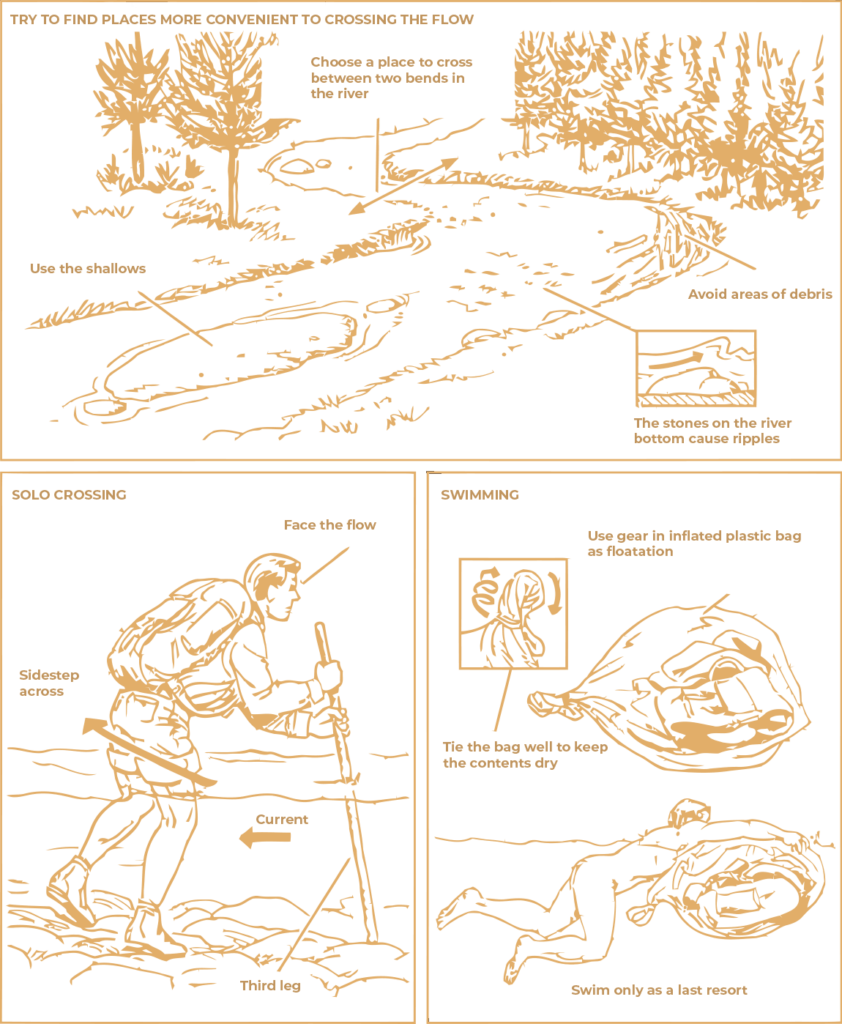
Crossing the river, find a long stick that will provide you with additional support and thereby increase your stability. When crossing the river, stand facing the current and move slowly but purposefully. When accelerating, the flow of water can knock you off your feet. If you have to swim to the other side, take off your clothes and put everything you have with you in a large garbage bag. Tie it securely so that air remains inside, so that the bag can be used as a floating craft. Swim diagonally against the current and choose a course with drift in mind.






